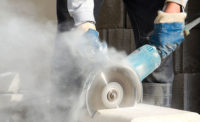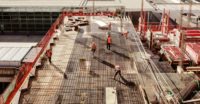Establishing any construction project is a careful balancing act between many legal, financial and social responsibilities. Firms not only have a responsibility to shareholders and business partners, but to their workers, the local authority and site neighbors in the wider community as well.
Managing the latter set of responsibilities, while maintaining consistent project delivery, is something that Gibraltar based concrete fabrication and construction contractor, Basewell Ltd, found to be a learning curve during the early days of the company. Established in 2010, the company was on the ground level of Gibraltar’s construction boom and has since grown to supply major construction companies on the island including GJBS, SITUS, SACYR and CASAIS.
Supplying and fabricating concrete meant that Basewell Ltd was faced with managing one of the most pervasive of construction site environmental hazards – dust. Exposure to high levels of dust can lead to long term health effects including respiratory illnesses and more immediate health risks such as eye and airway irritation and asthma attacks.
Figures from the United Nation’s International Labour Organisation estimate that around 17% of global worker deaths are attributable to respiratory diseases[1], making the monitoring for and control of respiratory hazards such as construction site dust a vital responsibility.
There are several methods to monitor for construction site dust, which include fence line or site boundary monitoring. Several monitoring solutions are set up around the perimeter of the site and consistently monitor levels of dust (and potentially other hazards like excess levels of noise and vibration), capturing data and alerting users to any breach in acceptable levels.
This is the method that Basewell Ltd employed, using the Casella Guardian2 combined boundary monitoring solution. The Environmental Agency Gibraltar sets out a need to monitor and control dust levels in the Environmental (Control of Dust) Regulations 2010[2]. In order for the company to gain its certificate of approval to operate, Basewell Ltd needed to outline a dust plan policy and provide monthly dust level reports from its sites to the agency.
Prior to the installation of the Casella Guardian2, monitoring for dust levels was only conducted visually, and inspectors from the Environmental Agency would visit Basewell Ltd’s sites frequently to conduct inspections. Managing legal and regulatory responsibility, and the expectations from external agencies and local authorities, is a key part of project management. This can be very time consuming, managing site visits from inspectors and producing reports of hazard levels to a regular schedule.
The Guardian2 is equipped with a function that allows data to be captured and reports to be automatically generated and sent to multiple recipients via SMS or email. This also enables users to set up alerts for when parameters for a particular hazard are exceeded. This allows site safety managers to monitor hazard levels remotely across multiple projects, and also allowed Basewell Ltd to easily automate reports on dust levels and send these reports on to the Environmental Agency. The result was not only increased the ease of regulatory compliance and hazard monitoring, but over the course of a year the Environmental Agency’s site visits have reduced substantially as Basewell are able to provide all the necessary monitoring data regularly and remotely.
Using the Guardian2 site boundary monitor has allowed Basewell Ltd not only to increase levels of worker safety on site by identifying which activities produce high levels of dust and the counter measures needed to reduce it, but it has also promoted a positive and responsible relationship with the environmental authority. The use of automated, hands free reporting and continuous data capture ensures a record of full accountability is easily accessible at all times and allows Basewell Ltd to focus on what they do best – servicing Gibraltar’s concrete needs as one of the most reliable contactors on the Rock.






